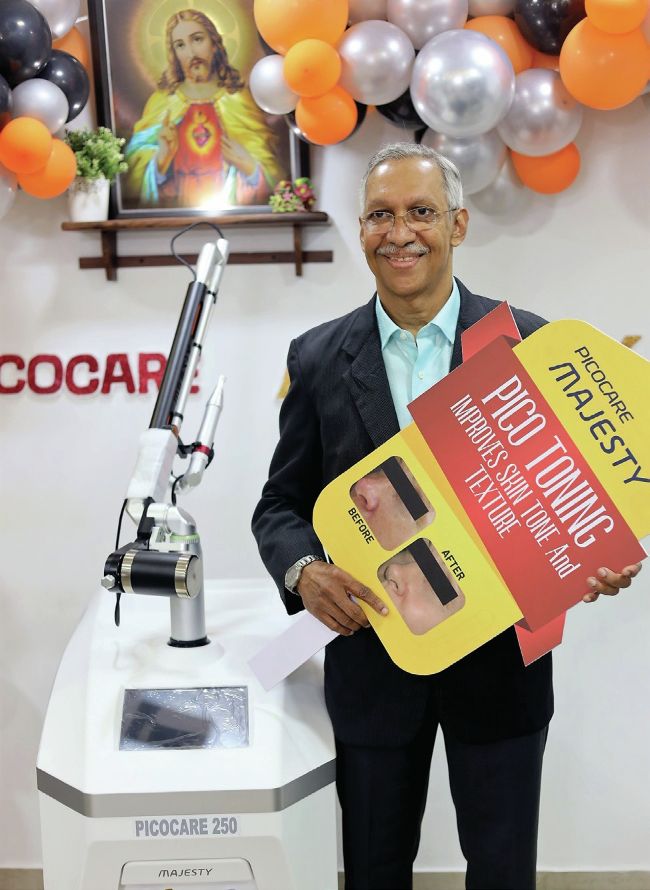IN PARTNERSHIP WITH
Take a picosecond!
Discover the wonders of picosecond laser therapy for flawless and radiant skin with Aesthetic Medicine India, in collaboration with Aakaar Medical Technologies. Shriyal Sethumadhavan speaks with dermatologists on the effectiveness of the device for treating scars, wrinkles, tattoos, and hyperpigmentation, and their experience with picosecond lasers.
Shriyal Sethumadhavan
According to a report by Grand View Research, the global market for lasers is expected to continue growing at a CAGR of 16.2 per cent from 2021 to 2028, driven by increasing demand for cosmetic treatments and advancements in laser technology. The pandemic has further accelerated the demand for noninvasive treatments, leading to the emergence of new technologies such as picosecond lasers.
Picosecond lasers, such as the Picocare Majesty 250 and Picocare 450 from Aakar Medical Technologies, have revolutionised the field of dermatology by providing a faster and more effective method of removing unwanted tattoos, scars, and pigmentation, as well as rejuvenating the skin. In fact, the Picosecond Majesty 250 is the world’s first 250 picosecond laser. These lasers emit ultra-short pulses of energy in the picosecond range, which is one trillionth of a second. It is important to note that not all “picosecond” lasers are created equal, as many lasers on the market claim to be “pico” but actually emit pulses that are much longer, in the range of nanoseconds. True picosecond lasers can deliver more energy in a shorter period, making them more efficient and less harmful to surrounding tissues. Dermatologists should look for FDA-approved devices that have been tested and verified to emit pulses in the picosecond range and can be customised to the patient’s needs.
One of the most significant advantages of picosecond lasers is their ability to treat skin conditions at a faster pace. Traditional laser treatments can take several sessions to achieve the desired results, while picosecond lasers can deliver the same results in fewer sessions, reducing discomfort and downtime, as well as saving patients’ time and money in the long run.
The emergence of picosecond lasers is offering a new level of precision and efficiency for aesthetic medicine practitioners, and with several doctors already understanding its competence, it is likely that many more practitioners will adopt this technology in the coming years to provide their patients with optimal outcomes for their aesthetic concerns.
Read on to explore the benefits of laser treatments for various skin concerns, with a focus on the advantages of picosecond lasers for dermatologists.
“By investing in pico lasers, practitioners can expect RoI within just two to three years.”
Dr George Varghese Koluthara Medical Director, Doctors Aesthetic Centre
Tell us about your experience using picosecond lasers and Nano Q-switch technologies in your clinic.
We were using Nano Q switched laser from 2010 to 2019. We purchased Picocare 450 in 2019 and exchanged it Picocare Majesty 250 in February 2023. While using Nano Q-Switched laser, we found difficulties in treating colour tattoo, Naevus of Ota, and melasma, and the number of sessions required was much more than that with picosecond laser. Picocare 450 laser is useful for treatment of colour tattoo, Naevus of Ota, melasma, open pores and improvement of skin texture and tone. It has MLA (micro lens array) hand piece, which is useful for the treatment of open pores and improvement of skin texture. Our inflow of patients increased after we installed Picocare 450 due to good results and word of mouth.
The picosecond laser has numerous advantages. It is safe and effective for all skin types, treats multi-coloured tattoos and epidermal/dermal lesions. It is a safer treatment that won’t cause hypo/hyperpigmentation and requires fewer sessions compared to nanosecond lasers. It can treat acne, atrophic, and hypertrophic scars, as well as improve uneven skin tone/ texture, fine lines/wrinkles, and enlarged pores. Overall, the picosecond laser is a versatile and reliable option for a range of skin concerns, making it a popular choice among patients.
What are the key differences between picosecond and nano Q-switch technologies, and which do you find more effective for specific treatments?
The Q-switched laser primarily relies on photo-thermal effects, while picosecond lasers work on photo-acoustic effects, resulting in fewer treatments. However, Q-switched lasers can cause hyper and hypo-pigmentation due to the epidermis being more susceptible to thermal injury. Picosecond lasers are more effective for dermal lesions, such as Naevus of Ota and pigmentation, and are better suited for treating colour tattoos. Q-switched lasers work on the principle of thermal relaxation time, while picosecond lasers operate on the principle of stress relaxation time. Additionally, picosecond lasers utilise Laser Induced Optical Breakdown (LIOB), which is a new type of fractional injury that preserves the epithelium and basal membrane, resulting in less pain, fewer complications, and faster healing.

Dr George Varghese
How do you see the use of these technologies evolving in the future?
At our center, we have 23 years of experience in skin laser and aesthetic procedures, and we always strive to bring the latest updated technology. One such innovation is the Picosecond Majesty 250. This advanced technology is set to replace Q-switched lasers in the near future, providing even better results for our clients.
What advice would you give to other doctors who are considering investing in these technologies for their clinics?
Picosecond lasers outperform nano lasers, delivering better results in fewer sessions with fewer complications. They effectively treat a range of skin issues, from acne and atrophic scars to colour tattoos and dermal pigments. Our experience investing in picosecond lasers, particularly the Picocare 450, demonstrates that practitioners can expect RoI within just two to three years. Picosecond lasers are a smart investment for practices seeking to provide top-tier laser treatments.
“Pico lasers outperform Nano lasers, delivering better results in fewer sessions. They effectively treat a range of skin issues, from acne and atrophic scars to colour tattoos and dermal pigments.”